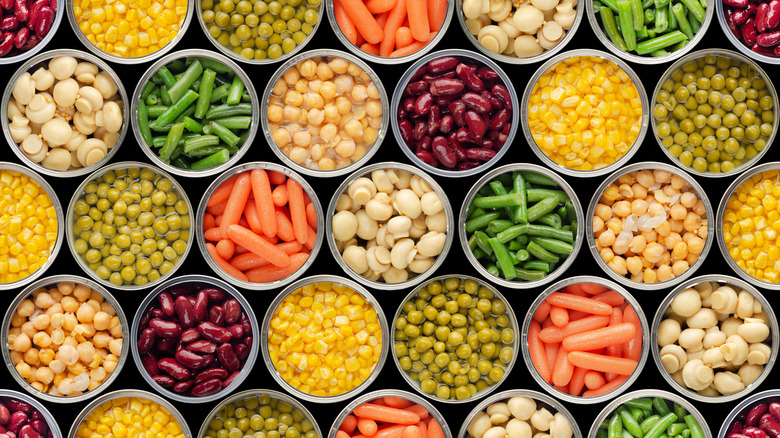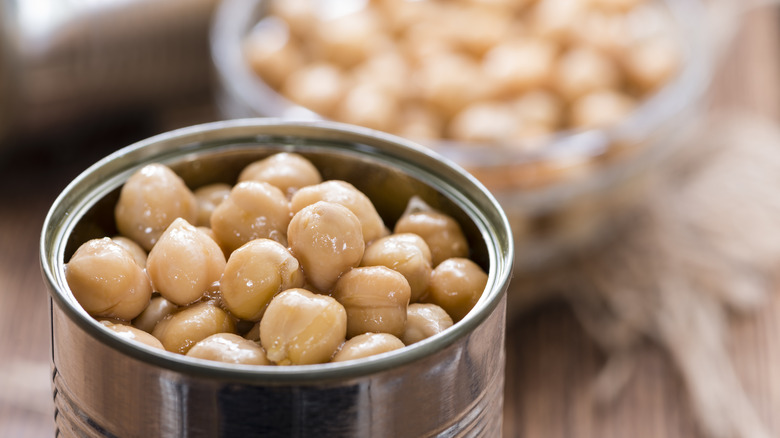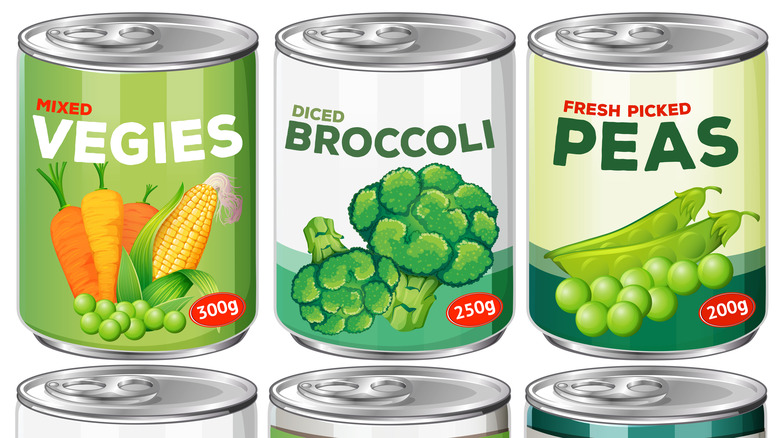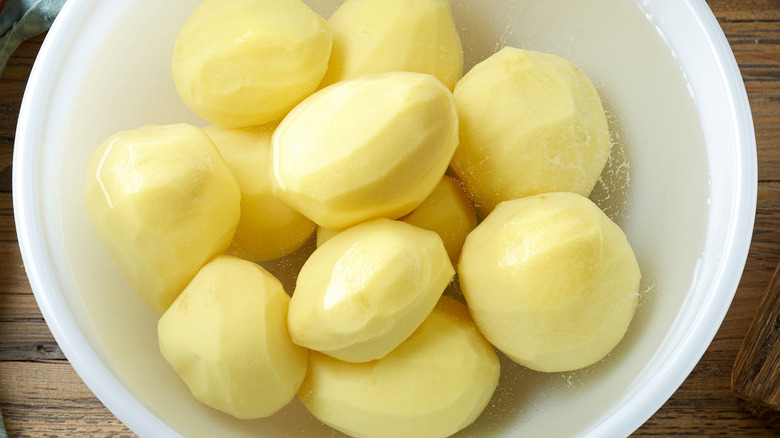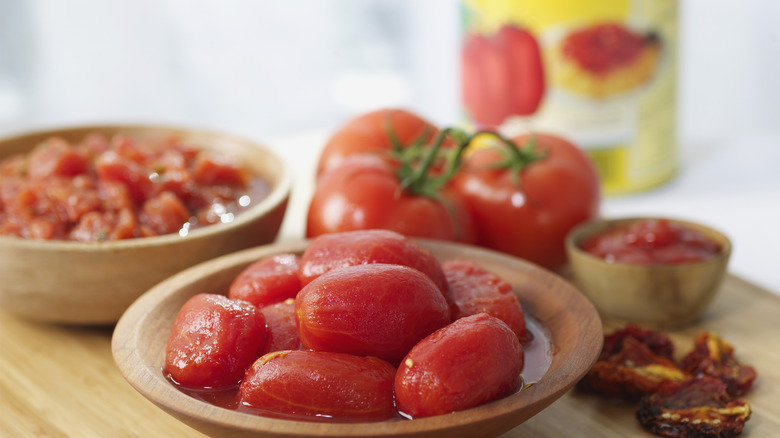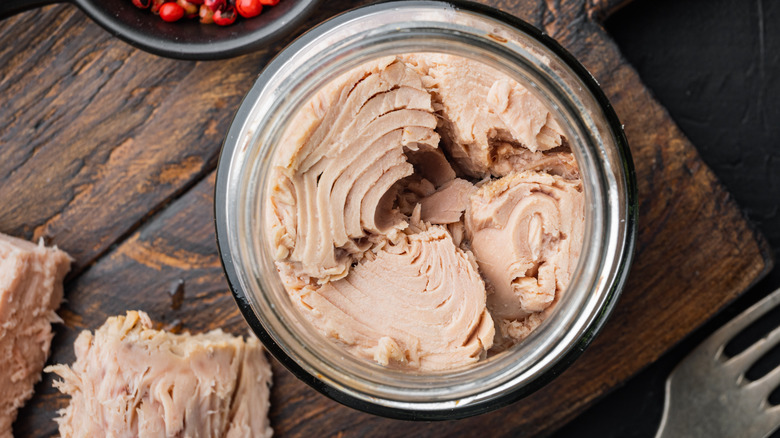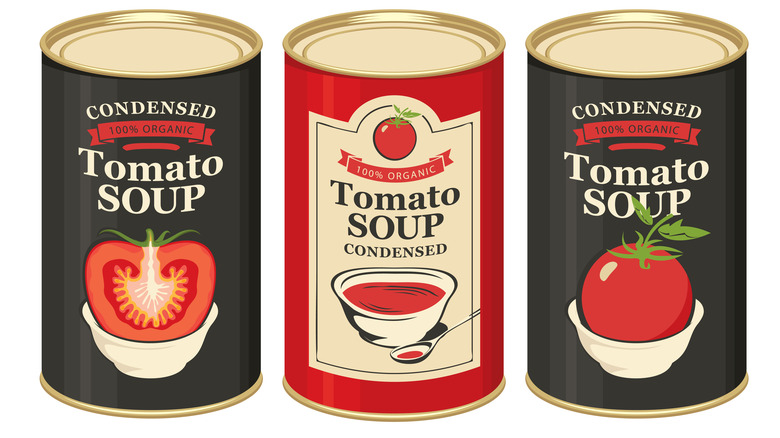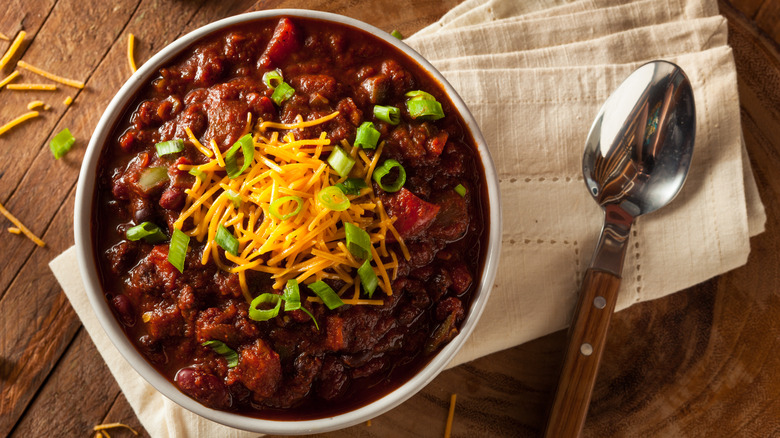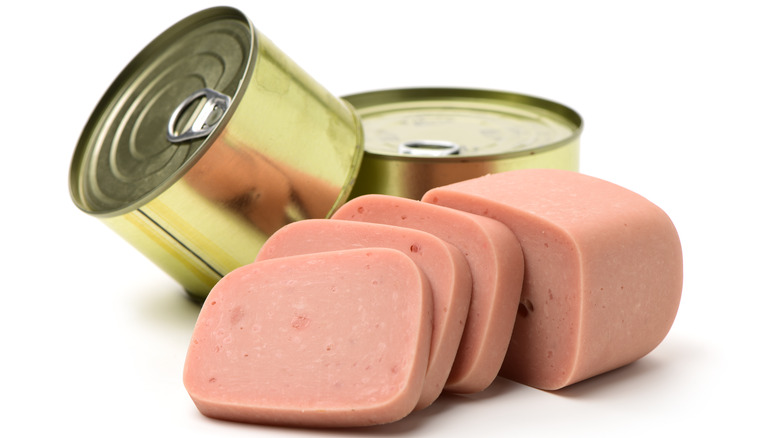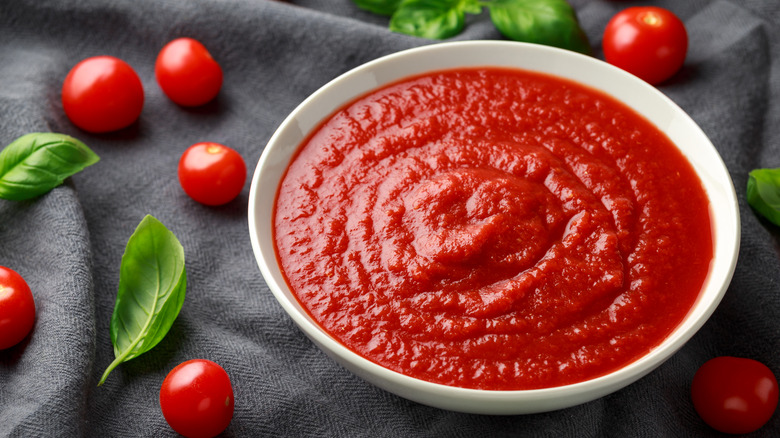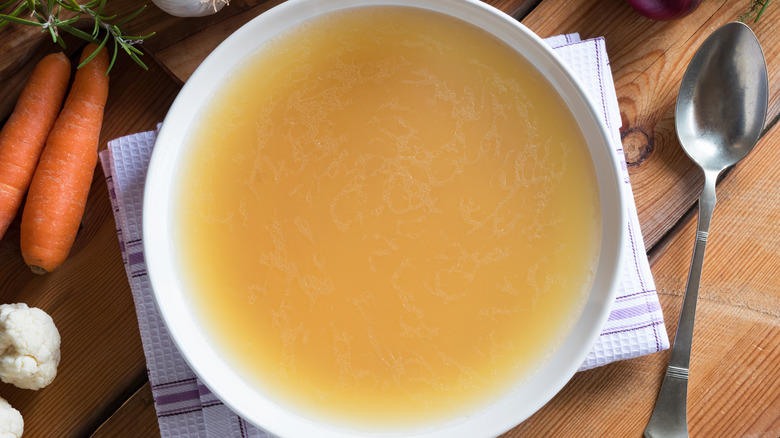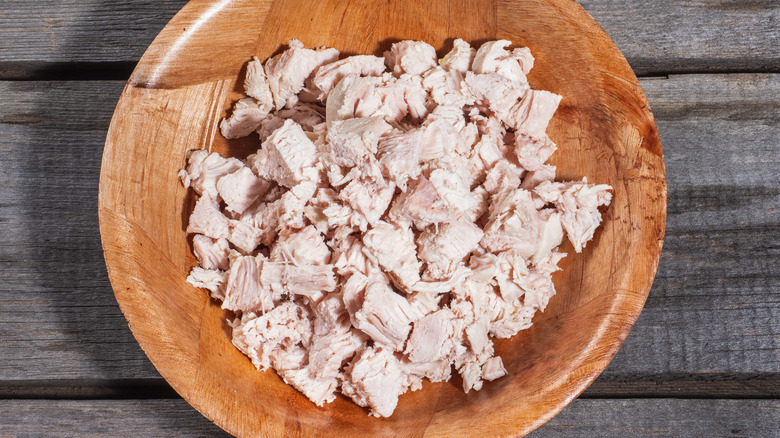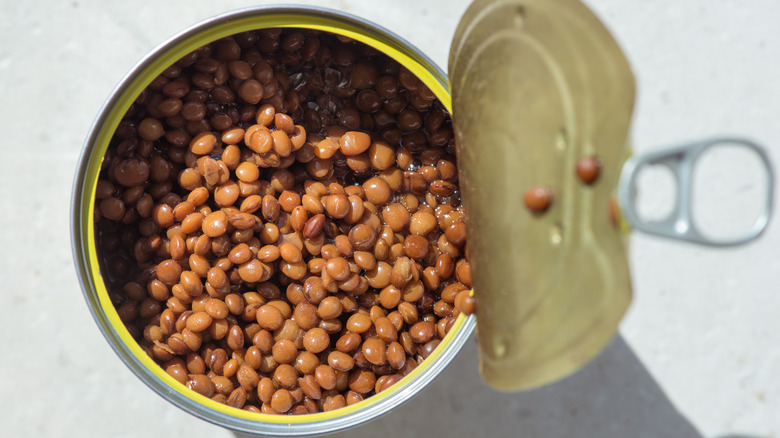15 Consistently Least Expensive Canned Foods To Buy
The costs of essentials are increasing — especially food. One of the ways you can reduce your food bill is by choosing canned foods. For even greater savings, purchase canned food items at discount stores — like Big Lots and Dollar General — and budget grocery chains like Aldi. Or, opt for generic or in-store brands and buy in bulk when on sale.
Always stroll down the canned food aisle when you're at the market, even if you don't plan on using them right away. Non-perishable canned foods have a long shelf life and can be easily stored in your pantry for months (and sometimes years). In other words, don't hesitate to take advantage of that four for $5 deal on canned beans!
Canned foods are convenient and often just as nutritious as their fresh counterparts. They can be incorporated into a meal or, depending on the type of food, can serve as a stand-alone meal. They're a huge time-saver, cutting down on prep time while offering nutritional value. And if you find yourself discarding fresh produce due to spoilage, buying canned foods may be the perfect solution.
With today's inflation, dining out is expensive, and for many, eating in has also become a financial strain. So, stock up on canned items to help you prepare quick and delicious meals for your family while saving money. Here are 15 budget-friendly canned food options to help you get started.
Beans
Beans are a terrific way to introduce yourself to canned foods because cooking with them is as easy as opening the can. They are a ready-to-use product that's way more convenient than dried beans, which require time and effort to sort, soak, rinse, and cook before even adding to a dish.
If you're not a regular bean eater, consider changing. Beans are an excellent source of folate, magnesium, and iron. And when paired with foods high in vitamin C — like broccoli and tomatoes — beans can help increase iron absorption. In addition, these small bites of protein are fiber-rich, making you feel full and satisfied.
We love beans because there are so many different varieties to choose from. Next time you make hummus, experiment with cannellini beans or black beans instead of chickpeas. Navy beans make superb additions to chilis and stews, and Great Northerns add heft to salads. Beans are also great for thickening soups when mashed and hefty enough to use in veggie burgers.
Vegetables
The healthiest choice for our bodies is to buy fresh vegetables as close to harvesting as possible. But if you've been to a farmer's market lately, you know how expensive that can be. Now is the perfect time to give canned vegetables a try.
Depending on age and gender, the USDA recommends that adults consume 2 to 4 cups of vegetables per day as part of a healthy diet. Canned vegetables help you reach those recommendations by allowing you to always have vegetables within arm's reach. Plus, you'll be able to worry less about what veggies to serve with dinner when you've got a pantry full of canned vegetables.
Corn, peas, carrots, and green beans regularly top lists of popular canned vegetables. Toss some corn into zesty cowboy caviar, brighten a kale salad with carrots, or use peas as a last-minute addition to fried rice. Green beans add a nutritious touch to soups and don't even consider substituting them for fresh in green bean casserole. Admittingly, canning can affect the flavor and texture of certain vegetables. If that's the case, try leveling up those canned veggies by roasting them in a hot oven with olive oil and salt.
Potatoes
If you've ever anguished over the discovery of spoiled spuds in your kitchen drawer, give canned potatoes a try. They can easily be substituted for fresh ones, whether a recipe calls for baking, broiling, or frying. Plus, canned potatoes come already peeled and cooked for you, saving you the hassle of having to prep them. The best part? You can buy them sliced or whole, giving you more cooking options and saving you even more time.
You (and your wallet) will love how easy canned potatoes are to use instead of fresh ones. You can eat them straight from the can, although we recommend applying seasonings and heat first. During the holidays, canned sweet potatoes are a lifesaver and make the best candied side dish. Drain and empty the sweet potatoes into a small baking dish. Dab with a generous amount of butter, sprinkle with brown sugar, salt, and vanilla, then bake at 400 degrees Fahrenheit until bubbly and heated through.
Use canned potatoes to make the fastest, easiest potato salad ever. Or, pan-fry them in olive oil and garlic when you're at a loss for a tasty side dish. Give them a try. We're confident they'll soon become a staple in your pantry.
Tomatoes
One of the most versatile shelf-stable foods, canned tomatoes are a pantry essential. They're easy to cook with, preserved at their prime, and just as nutritious as fresh. Their concentrated flavor, bright color, and juiciness make them great for pasta dishes, soups, and warming stews. You can use them in everything from marinara sauce and eggplant Parmesan to jambalaya and chili.
Don't get us wrong, fresh tomatoes rock our world, but the sweetest, most succulent ones are only available during summer. And while you wouldn't put canned tomatoes on a salad, they're perfect for quick sauces, curries, and chilis. Thanks to canned tomatoes, you can enjoy the bright flavor of tomatoes all year long.
Many different brands of canned tomatoes are available and come in all sorts of forms. Whether diced, crushed, or whole, canned tomatoes can be used in everything from simple sauces to heartier dishes like chicken cacciatore. Plus, according to Healthline, tomatoes are a terrific source of the antioxidant lycopene, which is associated with a lower risk of illnesses like heart disease and certain cancers.
Fruits
Picked at peak ripeness, canned fruit lets you enjoy seasonal fruit, like peaches and pears, throughout the year. Look for fruit packed in juice with no artificial color, and serve canned fruit as is, over yogurt, blended into a smoothie, or over pancakes.
Canned fruit can also be used in baked goods. If you're a baker, you know the secret to any good carrot cake is canned, crushed pineapple. Prefer drinking over baking? Swap your sweetener for canned fruit in your next cocktail. Muddle some canned peaches into your next Old Fashioned for a tantalizing, fruity beverage that will leave you warm and cozy.
One of our favorite canned fruits is pumpkin. It's a phenomenal product to always have on hand in your pantry, and if you've ever tried making pumpkin purée from scratch, you likely agree. It has virtually no fat, sodium, or added sugar, and despite popular belief, you can use canned pumpkin for more than just pie. Pumpkin adds sweet wholesomeness to banana bread and turns pancakes into moist, flavorful breakfast yumminess.
Tuna
Tuna from a can is high in protein, low in fat, and a great source of healthy omega-3 essential fatty acids. The American Heart Association and the Dietary Guidelines for Americans recommend that adults eat two (3.5-ounce) servings of fish a week. But for many people who don't live near the ocean, fresh fish isn't readily available. Canned tuna allows them to include fish in their diets easily — and cheaply.
Tuna fish is one of the most popular canned food items out there. Undoubtedly, a can of tuna is sitting in almost everyone's kitchen pantry. And while it's great for making quick lunch sandwiches, there are many other creative ways to use this healthful protein.
Pop open a tin of tuna and mix it into a hot, baked, cheesy casserole that feeds crowds. Or, dress up pasta with tuna chunks, olives, and feta cheese for a Mediterranean-inspired meal. Our favorite way to use canned tuna? Croquettes. Blended with herbs, seasonings, and eggs, then rolled in breadcrumbs, these tender tuna cakes will turn "Fish Friday" into your family's favorite day of the week.
Soups
When cooler weather rolls around, you'll be glad you stocked up on canned soups. They're quick to prepare and can be easily customized to your tastes by adding other ingredients, like noodles, vegetables, or beans.
Canned soups get a bad rap for being high in sodium and made with thickeners high in fat and calories, like egg yolks, cream, and cornstarch. We don't deny this, so look for soups labeled low or reduced sodium, low-fat, and organic. Stick to tomato, lentil, and vegetable soups while veering away from creamy chowders and bisques. You'll enjoy a comforting, nutritious meal while staying hydrated if you make good choices.
Pro tip: If you're not yet sold on canned soup, view it as a starting point. Try adding spices, pressed garlic, or fresh herbs. Or, stir in a handful of shredded cheese, leftover rice, or fresh protein, like tofu or shredded chicken. Our favorite add-in? Pesto. Swirled into almost any canned soup, pesto adds a dimension of flavor that's hard to beat.
Chili
Making chili from scratch has a level of enjoyment and satisfaction. But if you're short on time, canned chili is a delicious, affordable alternative. It's a meal-in-a-can perfect for a busy weeknight dinner.
You can serve canned chili in various ways, including straight from the can. Enjoy it warmed up with cornbread or smothered over a steaming baked potato, crisp nachos, or golden french fries. If it needs some pizazz, add homemade chili seasoning to give it the upgrade you want. Remember, chili also makes a superb, satisfying filling for tacos, burritos, and hollowed bell peppers.
If canned chili on its own doesn't float your boat, use it as a base and add fresh ingredients — like cilantro and jalapeño — for bright flavor. Or, sauté those green peppers in your vegetable drawer that have been creeping past their prime, then mix them into canned chili for some serious crunch. With a few simple additions, you'll have a nourishing weeknight meal that tastes homemade.
There are many canned chili options for all sorts of diets: vegetarian, meat, and no-bean, to name a few. As with other canned items, consider buying low-sodium.
Luncheon meat
We get it. Canned luncheon meat isn't for everyone. But if your bank account is the lowest it's been in months, this affordable, shelf-stable food might be what you need.
Luncheon meats contain meat, water, and curing ingredients (salt and nitrates). Fat, spices, and additives are sometimes also present. As you may have guessed, luncheon meats are high in calories, so eat them sparingly. Nevertheless, keeping a few cans in your pantry is worth it for creating cost-effective meals.
There are some fantastic ways to use luncheon meats. Because it's pre-cooked and a breeze to slice evenly, luncheon meats are great for layering in sandwiches or cutting into cubes for ramen soup, fried rice, and stir-fries. We love it cut into strips, pan-seared, and wrapped in soft tortillas with a chipotle cabbage slaw for epic tacos. And it's the perfect salty protein needed in our weekend morning hashes.
We couldn't talk about luncheon meat without mentioning Spam. It's one of the most polarizing brands — people either love or detest it. But, whichever side you're on, its cultural status can't be denied. Hormel Foods introduced Spam to the masses in 1937 as inexpensive meat, a much-welcome product during the Great Depression. Spam continued to grow in popularity during World War II because its long shelf life allowed it to be shipped to military troops across the country. To this day, Spam remains a budget-friendly food worldwide and a staple in Hawaii.
Pasta sauce
Pasta sauce is a handy food to keep in your pantry so you can enjoy quick and easy Italian dishes. Heat the sauce in a pot while your pasta cooks, and you'll have a tasty meal in less than 10 minutes. And though it likely won't win a culinary award anytime soon, canned pasta sauce has its purposes, like feeding hungry kiddos, taking on RV trips, or stocking up for emergency preparedness.
We're aware that canned pasta sauce can be pretty bland. Fortunately, there are easy ways to improve its flavor by adding other ingredients, like fresh basil, red pepper flakes, and fresh garlic. Or, stir in some dried oregano and a pinch of sugar and use it as pizza sauce.
Pro tip: Allow the pasta sauce to simmer on the stovetop for 5 to 10 minutes before tossing it with cooked pasta. The added cook time allows the sauce to thicken and flavors to concentrate for that same richness found in homemade sauces.
Broth
A pantry essential for home cooks, canned broth is a savory base used in countless dishes. You can steep broth with herbs and white wine to use as a flavorful poaching liquid for fish. Or, turn the broth into a satisfying soup by adding a protein and grain, like chicken and rice. And when used to scrape up browned bits left in a pan after searing meat, broth makes a superb base for pan gravies and stews.
Canned broth is a terrific source of vitamins, minerals, and fluid to fight everyday ailments like colds and flu. Nothing soothes a sore throat better than a cup of warm broth, don't you agree? One of our favorite immune-boosting soups is egg drop, and canned broth makes it so easy to prepare. Drizzle whisked egg into a simmering pot of broth for a nourishing soup sprinkled with lots of fresh, minced garlic and sliced scallions.
While both animal and plant-based broths are available, many are loaded with salt. High-sodium broth not only leads to high blood pressure but also affects the flavoring of your final dish, so always choose lower-sodium options.
Chicken
If you need a quick and easy lean protein, canned chicken is an excellent choice. Because it's fully cooked and ready to eat, canned chicken is great for last-minute meals. Mix it with some mayonnaise and spices for an easy lunch, or use it in salads and sandwiches. If you're a fan of BBQ chicken pizza, having canned chicken in your pantry is a must.
You can also use canned chicken in more elaborate meals to reduce prep time. For example, next time you make pot pie, go with canned chicken — and while you're at it, use a store-bought pie crust (we won't tell). We're confident your guests won't know the difference, and you'll be chuckling all night. Chicken from a can also work well in saucy dishes like tikka masala and stir-fried with bell peppers and onions for fantastic tacos.
Canned chicken is a portable protein perfect for camping and road trips. Simple, on-the-go meals like quesadillas and wraps are easy to make with canned chicken. In addition, chicken meat is a good source of vitamins B and D, calcium, iron, and zinc, which will keep your body energized and nourished. And in case you were wondering, canned chicken offers the same nutrients as fresh chicken. (Sweet!)
Sausage
Canned sausage, or Vienna sausage, is a prepared food made with ground pork, beef, or chicken in a casing of sheep's intestine, smoked at low temperature. They're great for snacking when you need a boost of energy, and you can eat them right out of the can — no cooking required. While they're not the healthiest canned meats, these little sausages are savory, convenient, and incredibly cheap.
Even though canned sausages are ready to eat, you can heat them and add them to dishes. They're excellent when seared in a pan or added to pasta sauces and casseroles. We love them for breakfast. Chop the sausages into bite-sized pieces and cook them in a cast iron skillet with diced potatoes and onions for a mouthwatering breakfast hash with eggs. Or, if you're looking for a fun, savory appetizer, roll them up in crescent rolls for classic pigs in a blanket. Put these adorable bite-sized snacks out at your next get-together, and we guarantee they'll be the first to go!
Lentils
Canned lentils are earthy-flavored, edible seeds ready to be used straight out of the can. They are a gift for busy home cooks who don't have time to sort, rinse, and cook dried lentils. And since canned lentils come pre-cooked, they can be thrown into dishes and will be ready in minutes.
A high source of protein, lentils are a good substitute for meat and fish and can be used to bulk up vegetarian dishes. They are a great plant-based protein for meat-free meals, providing heartiness and textural contrast — like in this vegan lasagna. In addition, lentils are a rich source of gut-friendly fiber that promotes digestive function and are great for serving with main dishes when you feel like changing things up from the usual sides of rice or potatoes. Lentils are perfect for mashing, too, and we love blending them with spices and breadcrumbs to form flavorful lentil burgers.
Just remember to avoid lentils packed in salted water. If that's the only kind available, rinse to remove excess salt before using them.
Milk
Canned milk, or evaporated milk, is made from fresh milk that has been heated to remove over 50 percent of its water content. Evaporated milk can be made from whole or skim milk and has a creamy, almost syrupy texture with a concentrated level of nutrients.
Evaporated milk can be drunk directly from the can as an alternative to milk. You can also thin it with water to more closely resemble fresh milk. In addition, it has an incredibly long shelf life (years), making it an indispensable food item in areas of the world where fresh milk is not easily obtained and refrigeration isn't possible.
Canned milk is often used in baking when making classic recipes for old-fashioned frostings, pumpkin pie, and fudge. Depending on the recipe, bakers often find success substituting evaporated milk for fresh milk or heavy cream. In savory cooking, evaporated milk is a good substitute for half-and-half, adding creaminess to dressings, sauces, soups, and gravies.
Static Media owns and operates Mashed and Daily Meal.
